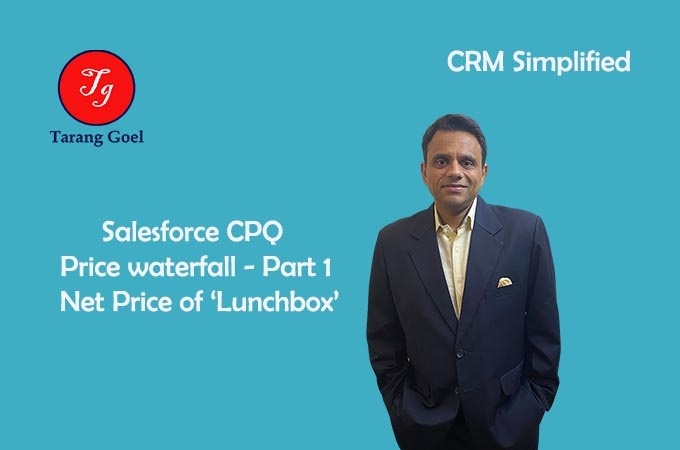Salesforce CPQ price waterfall is a calculation sequence to arrive at the net price for the customer. There are many types of prices and discounts available in Salesforce CPQ. Salesforce CPQ price waterfall defines a sequence to treat different prices with the end goal of arriving at the net price charged to the customer.
This calculation sequence allows for exceptions to the defined rules. We will use the knowledge of Salesforce CPQ price and look at the different scenarios to understand the pricing sequence practically. We will also look at exception scenarios. If you want to learn more about different types of CPQ pricing then you refer my blog sequence starting with subscription pricing for Lunchbox .
Before we go to the scenarios let’s quickly understand the types of pricing and calculation sequence.
1. List Price –> This is the primary price and comes first in the pricing waterfall. This is price of a product in Pricebook. For e.g. list price of ‘Lunchbox’ is $15. It should be noted that List price can be replaced with Block Prices, Percent of Total price and Cost-plus Mark up prices. All these prices work at the first level and replace list price if required. In this blog, we will work with a list price scenario. We will see other scenarios in the part 2 of this blog.
2. Regular price –> After List price regular price is calculated. Regular price is = List price minus (Discount schedules) or Regular Price = contracted price or Regular Price = Special price. There are different types of discount schedules quantity, term discount schedule or a slab-based schedule
3. Customer Price –> Next in price waterfall is the Customer Price. Customer Price is = Regular Price minus Additional Discounts Additional discounts can be applied manually on a quote by quote basis or can be applied conditionally through price rules.
4. Partner Price –> Next in line is the Partner Price. This is applicable if it is a B2B scenario. Partner Price = Customer Price – Partner discount
5. Distributor Price = Customer Price minus Distributor discount
6. Net Price is the distributor price
It should be noted if there is no partner price and distributor price then Customer becomes the net price and if there is no additional discount then the regular price becomes the partner price. The above-mentioned sequence is a standard sequence. There are exceptions to the above-mentioned sequence, and we will understand them practically in the part 3 of this blog. In part of 2 of this.
I will replace the List price with Block, cost plus, % of total and Contracted price to explain the price waterfall. You can also find more details on types of prices at this link: https://sforce.co/3cESsvT
Now, let us understand the price waterfall with the help of a vanilla scenario without a distributor price.
Scenario — Tango foods offering Lunchbox at a List price of $15. They are offering quantity-based discounts of 20% for quantity between100-200 and 30% of quantity between 201-300. There is an additional COVID discount of 10% on any quantity purchased. Kitchen Foods is one of the partners of Tango Foods and gets an additional 15% partner discount.
Let us see how the Salesforce price waterfall is sequence of calculation to get to the Net price for Kitchen Foods when they buy 120 Lunchboxes.
a) List Price– List price of $15 is set in the pricebook entry for Lunchbox.
b) Regular price is determined –> List Price minus System discount $15 – $3 = $12. Regular price is $13.5 per box
(20% of $15 is $3) (System discount of 10% is applicable as 120 lunchboxes are ordered.)
c) Calculation of customer price –> Regular price minus Additional discount $12- $1.2 = $10.8. Customer price is $10.8
(10% of $12 is $1.2) (Additional discount of 10% is applicable due to Covid)
d) Calculation of Partner price –> Customer price minus Partner discount $10.8 – $1.62 = $9.18. Partner price is $9.18
(15% of $10.8 is $1.62) (Partner discount of 15% is applicable to Tango Foods)
e) Calculation of Net Price –> Net Price is $9.18
(Since no distributor price à Partner Price= Net Price. Net Price is $9.18
f) Calculation of total price –> Net price * Quantity ($9.18 * 120) = $1101.6
Note: If an additional distributor discount of 5% was to be calculated then it would work the following way
a) Calculation of Distributor price –> Partner Price minus Distributor discount $9.18 – $.46 = $8.72
(5% of $9.18 is $.46) (Distributor discount of 5% is applicable)
b) Calculation of Net Price –> Net Price is $8.72
(Distributor Price = Net Price)
f) Calculation of total price –> Net price * Quantity $8.72 * 120 = $1046.4
I am hoping that I have made the concept of Salesforce CPQ Pricing waterfall easier to understand for you all. Your likes, comments and share’s will motivate me to keep writing.


1 Comment
Girish
June 16, 2020 - 2:27 amI think there is a typo.
5. Distributor Price = Customer Price minus Distributor discount.
Should the Customer Price be Partner Price?